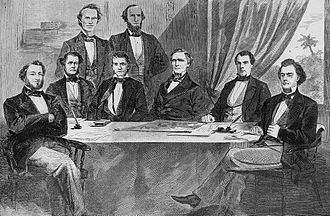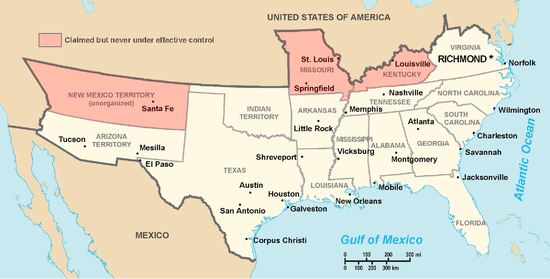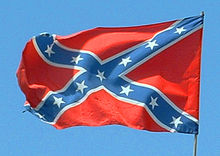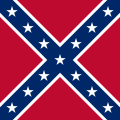Negeri-negeri Gabungan Amerika: Perbezaan antara semakan
k Membalikkan suntingan oleh 219.93.152.34 (Perbincangan) kepada versi terakhir oleh SieBot |
AlleborgoBot (bincang | sumb.) k bot menambah: tr:Amerika Konfedere Devletleri |
||
| Baris 705: | Baris 705: | ||
[[ta:அமெரிக்க மாநிலங்களின் கூட்டமைப்பு]] |
[[ta:அமெரிக்க மாநிலங்களின் கூட்டமைப்பு]] |
||
[[vi:Liên minh miền Nam Hoa Kỳ]] |
[[vi:Liên minh miền Nam Hoa Kỳ]] |
||
[[tr:Amerika Konfedere Devletleri]] |
|||
[[uk:Конфедеративні Штати Америки]] |
[[uk:Конфедеративні Штати Америки]] |
||
[[zh:美利堅聯盟國]] |
[[zh:美利堅聯盟國]] |
||
Semakan pada 19:20, 2 Disember 2008
Tolong bantu menterjemahkan sebahagian rencana ini. Rencana ini memerlukan kemaskini dalam Bahasa Melayu piawai Dewan Bahasa dan Pustaka. Sila membantu, bahan-bahan boleh didapati di Confederate States of America (Inggeris). Jika anda ingin menilai rencana ini, anda mungkin mahu menyemak di terjemahan Google. Walau bagaimanapun, jangan menambah terjemahan automatik kepada rencana, kerana ini biasanya mempunyai kualiti yang sangat teruk. Sumber-sumber bantuan: Pusat Rujukan Persuratan Melayu. |
Negeri-Negeri Gabungan Amerika Confederate States of America | |||||
|---|---|---|---|---|---|
| 1861–1865 | |||||
| |||||
| Cogan kata: Deo Vindice (Latin: Under God, Our Vindicator) | |||||
| Lagu kebangsaan: God Save the South (rasmi) The Bonnie Blue Flag (popular) | |||||
 | |||||
| Status | Gabungan | ||||
| Ibu negara | Montgomery, Alabama (until May 29 1861) Richmond, Virginia (May 29 1861–April 2 1865) Danville, Virginia (from April 3 1865) | ||||
| Bandar terbesar | New Orleans (4 February 1861–May 1 1862) (captured) Richmond (May1 1862–surrender) | ||||
| Bahasa yang umum digunakan | Bahasa Inggeris (de facto) | ||||
| Agama | Kebanyakannya Protestan & Katolik | ||||
| Kerajaan | Republik | ||||
| Presiden | |||||
| Naib Presiden | |||||
| Sejarah | |||||
• Penubuhan Gabungan | 4 Februari 1861 | ||||
| 12 April 1861 | |||||
• Penyerahan | 11 April 1865 | ||||
| Keluasan | |||||
| 18601 | 1,995,392 km2 (770,425 bt2) | ||||
| Populasi | |||||
• 18601 | 9103332 | ||||
• slaves2 | 3521110 | ||||
| Mata wang | Dolar CSA (hanya wang kertas dikeluarkan) | ||||
1Area and population values do not include Missouri & Kentucky nor the Territory of Arizona. Water area:5.7% 2Slaves included in above population count. 1860 Census | |||||
Negeri-Negeri Gabungan Amerika (juga dipanggil Konfederasi, Negeri-Negeri Konfederasi, dan CSA) merupakan kerajaan yang ditubuhkan oleh 11 negeri-negeri selatan di Amerika Syarikat dari 1861 hingga 1865. Tujuh buah negeri mengisytiharkan kemerdekaan dari Amerika Syarikat sebelum Abraham Lincoln menjadi presiden; empat lagi berbuat demikian selepas Perang Saudara Amerika bermula dengan Pertempuran Fort Sumter apabila CSA menyerang USA. Pihak (Kesatuan) atau Union Amerika Syarikat menolak perpecahan itu dan enggan mengiktirafkan kemerdekaan Gabungan. Walaupun tiada kuasa Eropah yang mengiktirafkan CSA secara rasmi, namun Britain mengambil kesempatan komersial dengan menjual kapal perang kepada CSA ini dan membawa kapal bekalan untuk membantu CSA.
Apabila Robert E. Lee serta panglima-panglima lain mengaku kalah pada musim bunga 1865, gabungan negeri ini hancur dan menamatkan peperangan itu tanpa pertempuran gerila. Proses pembinaan semula yang sukar dan lama memberi hak sivil secara sementara dan hak mengundi, mengusirkan bekas pemimpin-pemimpin Konfederasi daripada pejabat, dan menerima semula bekas negeri-negeri Konfederasi ke dalam Kongres Amerika Syarikat selama-lamanya.
Sejarah
Punca-punca pemisahan
Ahli sejarah mengatakan punca pemisahan adalah kerana ancaman untuk menghad atau menamatkan perhambaan oleh pihak Republikan atau sekatan ke atas hak negeri berhubung pemilikan hamba di dalam jajahan-jajahan menyebabkan negeri-negeri selatan keluar dari Gabungan.
Negeri-negeri pemisah

Templat:Confederate Tujuh negeri yang berpisah pada Februari 1861:
- Carolina Selatan (20 Disember 1860),[1]
- Mississippi (9 Januari 1861),[2]
- Florida (10 Januari, 1861),[3]
- Alabama (11 Januari, 1861),[4]
- Georgia (19 Januari, 1861),[5]
- Louisiana (26 Januari, 1861),[6]
- Texas (1 Februari, 1861).[7]
Setleah Lincoln mengerah tentera, empat lagi negeri berpisah:
- Virginia (17 April, 1861);[8] juga wujudnya kerajaan kecil bergelar Kerajaan Kesatuan Virginia[9]
- Arkansas (6 Mei, 1861),[10]
- Carolina Utara (20 Mei, 1861)[11]
- Tennessee (8 Jun, 1861).[12][13]
Dua buah negeri lain menubuhkan kerajaan saingan (atau punggung). Gabungan mengakui negeri-negeri tersebut tetapi tidak mengawal negeri-negeri ini dan kerajaan negeri penyokong Gabungan ini dibuang negeri:
- Missouri tidak berpisah tetapi satu golongan mengisytiharkan pemisahan (31 Oktober, 1861).[14][15]
- Kentucky tidak berpisah tetapi segolongan pemisah yang tidak diundi mengisytiharkan pemisahan (20 November, 1861).[16][17]
Kedua-dua negeri membenarkan perhambaan dan mukimnya bercampur-aduk pihaknya dalam perang, termasuk penyimpan hamba berpihak kepada Kesatuan. Kesahan hal ini masih diragui sehingga hari ini.
Kebangkitan dan keruntuhan Gabungan
Tolong bantu menterjemahkan sebahagian rencana ini. Rencana ini memerlukan kemaskini dalam Bahasa Melayu piawai Dewan Bahasa dan Pustaka. Sila membantu, bahan-bahan boleh didapati di Confederate States of America (Inggeris). Jika anda ingin menilai rencana ini, anda mungkin mahu menyemak di terjemahan Google. Walau bagaimanapun, jangan menambah terjemahan automatik kepada rencana, kerana ini biasanya mempunyai kualiti yang sangat teruk. Sumber-sumber bantuan: Pusat Rujukan Persuratan Melayu. |
Kerajaan dan politik
Perlembagaan

Presiden 1861-1865
Tolong bantu menterjemahkan sebahagian rencana ini. Rencana ini memerlukan kemaskini dalam Bahasa Melayu piawai Dewan Bahasa dan Pustaka. Sila membantu, bahan-bahan boleh didapati di Confederate States of America (Inggeris). Jika anda ingin menilai rencana ini, anda mungkin mahu menyemak di terjemahan Google. Walau bagaimanapun, jangan menambah terjemahan automatik kepada rencana, kerana ini biasanya mempunyai kualiti yang sangat teruk. Sumber-sumber bantuan: Pusat Rujukan Persuratan Melayu. |
Kebebasan rakyat
Ibu kota
Ibu negara untuk Negeri-Negeri Gabungan Amerika ialah Montgomery, Alabama, dari 4 February, 1861, hingga 29 Mei, 1861. Richmond, Virginia, dijadikan ibu negara yang baru pada 6 Mei, 1861. Dalam masa singkat sebelum tamatnya, Kerajaan Kesatuan telah menduduki Richmond dan merancang untuk meneruskan pendudukan di Selatan. Little came of these plans before Lee's surrender at Appomattox Court House. Danville, Virginia, served as the last capital of the Confederate States of America, from April 3 to April 10, 1865.
Diplomasi Antarabangsa
Sebaik sahaja perang dengan Amerika Syarikat bermula, harapan terbaik untuk meneruskan kewujudan Negeri-negeri Gabungan dengan campur tangan tentera oleh Britain dan Perancis. Amerika Syarikat sedar tentang hal ini dan dengan jelas menyatakan bahawa mengiktiraf Negeri-negeri Gabungan bermaksud berperang dengan Amerika Syarikat - dan terhentinya penghantaran makanan ke Britain. Ahli Negeri-negeri Gabungan yang mempercayai bahawa "kapas adalah raja" - iaitu Britain perlu menyokong Negeri-negeri Gabungan untuk mendapatkan kapas - telah terbukti salah. Britain, pada hakikatnya mempunyai simpanan kapas yang mencukupi pada tahun 1861 dan bergantung lebih kepada biji-bijian dari negeri-negeri Kesatuan.
"Died of states rights"
Perhubungan dengan Amerika Syarikat
Bendera-bendera Gabungan
-
Bendera negara pertama
"Stars and Bars" -
Bendera negara kedua
"Stainless Banner" -
Bendera negara ketiga
-
Bendera tentera laut
1861-1863 -
Bendera tentera laut
1863-1865 -
Bendera pertempuran
"Southern Cross"
Political leaders
Executive

| Jawatan | Nama | Masa menjawat |
| Presiden | Jefferson Davis | 1861-1865 |
| Naib Presiden | Alexander Stephens | 1861-1865 |
| Setiausaha | Robert Toombs | 1861 |
| Robert M.T. Hunter | 1861-1862 | |
| Judah P. Benjamin | 1862-1865 | |
| Bendahara | Christopher Memminger | 1861-1864 |
| George Trenholm | 1864-1865 | |
| John H. Reagan | 1865 | |
| Setiausaha Peperangan | Leroy Pope Walker | 1861 |
| Judah P. Benjamin | 1861-1862 | |
| George W. Randolph | 1862 | |
| James Seddon | 1862-1865 | |
| John C. Breckinridge | 1865 | |
| Setiausaha Tentera Laut | Stephen Mallory | 1861-1865 |
| Postmaster General | John H. Reagan | 1861-1865 |
| Attorney General | Judah P. Benjamin | 1861 |
| Thomas Bragg | 1861-1862 | |
| Thomas H. Watts | 1862-1863 | |
| George Davis | 1864-1865 | |
Legislative
Speakers of the Provisional Congress
- Robert Woodward Barnwell of South Carolina - February 4 1861
- Howell Cobb, Sr. of Georgia - February 4 1861-February 17 1862
- Thomas Stanhope Bocock of Virginia - February 18, 1862-March 18, 1865
Presidents pro tempore
- Howell Cobb, Sr. of Georgia
- Robert Woodward Barnwell of South Carolina
- Josiah Abigail Patterson Campbell of Mississippi
- Thomas Stanhope Bocock of Virginia
Tribal Representatives to Confederate Congress
- Elias Cornelius Boudinot 1862-65 - Cherokee
- Burton Allen Holder 1864-1865 Chickasaw
- Robert McDonald Jones 1863-65 - Choctaw
Sessions of the Confederate Congress
Judicial
Supreme court - not established
District Court
- Asa Biggs 1861-1865
- John White Brockenbrough 1861
- Alexander Mosby Clayton 1861
- Jesse J. Finley 1861-1862
Geografi

Iklim
River system
Rural areas
| # | Bandar | Bilangan penduduk pada tahun 1860 | U.S. rank | Dipulangkan kepada kawalan Amerika Syarikat |
|---|---|---|---|---|
| 1. | New Orleans, Louisiana | 168,675 | 6 | 1862 |
| 2. | Charleston, South Carolina | 40,522 | 22 | 1865 |
| 3. | Richmond, Virginia | 37,910 | 25 | 1865 |
| 4. | Mobile, Alabama | 29,258 | 27 | 1865 |
| 5. | Memphis, Tennessee | 22,623 | 38 | 1862 |
| 6. | Savannah, Georgia | 22,292 | 41 | 1864 |
| 7. | Petersburg, Virginia | 18,266 | 50 | 1865 |
| 8. | Nashville, Tennessee | 16,988 | 54 | 1862 |
| 9. | Norfolk, Virginia | 14,620 | 61 | 1862 |
| 10. | Augusta, Georgia | 12,493 | 77 | 1865 |
| 11. | Columbus, Georgia | 9,621 | 97 | 1865 |
| 12. | Atlanta, Georgia | 9,554 | 99 | 1864 |
| 13. | Wilmington, North Carolina | 9,553 | 100 | 1865 |
(Lihat juga Atlanta dalam Perang Saudara, Charleston, SC dalam Perang Saudara, Nashville dalam Perang Saudara, New Orleans dalam Perang Saudara, dan Richmond dalam Perang Saudara).
Economy
The Confederacy had an agrarian economy with exports, to a world market, of cotton, and, to a lesser extent, tobacco and sugarcane. Local food production included grains, hogs, cattle, and gardens. The 11 states produced $155 million in manufactured goods in 1860, chiefly from local grist mills, and lumber, processed tobacco, cotton goods and naval stores such as turpentine. The CSA adopted a low tariff of 15 per cent, but imposed it on all imports from the rest of the United States. [1] The tariff mattered little; the Confederacy's ports were blocked to commercial traffic by the Union's blockade, and very few people paid taxes on goods smuggled from the Union states. The government collected about $3.5 million in tariff revenue from the start of their war against the Union to late 1864. The lack of adequate financial resources led the Confederacy to finance the war through printing money, which led to high inflation.
Armed forces

The military armed forces of the Confederacy was comprised of three branches:
- Tentera Negeri-negeri Gabungan Amerika
- Tentera Laut Negeri-negeri Gabungan Amerika
- Marinir Negeri-negeri Gabungan Amerika
The Confederate military leadership included many veterans from the United States Army and United States Navy who had resigned their Federal commissions and had been appointed to senior positions in the Confederate armed forces. Many had served in the Mexican-American War (including Robert E. Lee and Jefferson Davis), but others had little or no military experience (such as Leonidas Polk, who had attended West Point but did not graduate.) The Confederate officer corps was composed in part of young men from slave-owning families, but many came from non-owners. The Confederacy appointed junior and field grade officers by election from the enlisted ranks. Although no Army service academy was established for the Confederacy, many colleges of the South (such as the The Citadel and Virginia Military Institute) maintained cadet corps that were seen as a training ground for Confederate military leadership. A naval academy was established in 1863, but no midshipmen had graduated by the time the Confederacy collapsed.
The rank and file of the Confederate armed forces consisted of white males with an average age between 16 and 28. Many thousands of slaves served as laborers, cooks, pioneers and in other non-combat roles. The Confederacy adopted conscription in 1862. Depleted by casualties, the military suffered chronic manpower shortages. After agitation from the Army, and at the demand of General Lee, slaves were enrolled in new combat units in the spring of 1865, with the promise of emancipation; they were in training when the war ended and did not serve in actual combat. [18]
Military leaders
Military leaders of the Confederacy (with their state of birth and highest rank[19]) included:

- Robert E. Lee (Virginia) - General and General-in-Chief (1865)
- Albert Sidney Johnston (Kentucky) - General
- Joseph E. Johnston (Virginia) - General
- Braxton Bragg (North Carolina) - General
- P.G.T. Beauregard (Louisiana) - General
- Richard Stoddert Ewell (Virginia) - Lieutenant General
- Samuel Cooper (New York) - General (Adjutant General and highest ranking general in the Army); not in combat
- James Longstreet (South Carolina) - Lieutenant General
- Thomas J. "Stonewall" Jackson (Virginia)- Lieutenant General
- John Hunt Morgan (Kentucky) - Brigadier General
- A.P. Hill (Virginia) - Lieutenant General
- John Bell Hood (Texas) - Lieutenant General
- Wade Hampton III (South Carolina) - Lieutenant General
- Nathan Bedford Forrest (Tennessee) - Lieutenant General
- John Singleton Mosby, the "Grey Ghost of the Confederacy" (Virginia) - Colonel
- J.E.B. Stuart (Virginia) - Major General
- Edward Porter Alexander (Georgia) - Brigadier General
- Franklin Buchanan (Maryland) - Admiral
- Raphael Semmes (Maryland) - Rear Admiral
- Josiah Tattnall (Georgia) - Commodore
- Stand Watie (Indian Territory, now Oklahoma) - Brigadier General (last to surrender)
- Leonidas Polk (North Carolina) - Lieutenant General
- Sterling Price (Virginia) - Major General
- Jubal Anderson Early (Virginia) - Lieutenant General
- Richard Taylor (Kentucky) - Lieutenant General (Son of U.S. President Zachary Taylor)
- Lloyd J. Beall (South Carolina) - Colonel - Commandant of the Confederate States Marine Corps
- Stephen Dodson Ramseur (North Carolina) Major General
- Camille Armand Jules Marie, Prince de Polignac (France) Major General
- John Austin Wharton (Tennessee) Major General
- Thomas L. Rosser (Virginia) Major General
Significant dates
See also
- Burr conspiracy
- Triangular Trade
- Golden Circle (Slavery)
- Origins of the American Civil War
- Southern United States
- History of the Southern United States
- Flags of the Confederate States of America
- Seal of the Confederate States of America
- Confederate States of America dollar
- Military history of the Confederate States
- Stamps and postal history of the Confederate States
- Confederados
- C.S.A.: The Confederate States of America, a 2004 mockumentary. Fictional account of an alternate history in which the Confederates won the American Civil War.
Notes
- ^ Teks Ordinan Pemisahan Karolina Selatan.
- ^ Teks Ordinan Pemisahan Mississippi.
- ^ Teks Ordinan Pemisahan Florida.
- ^ Teks Ordinan Pemisahan Alabama.
- ^ Teks Ordinan Pemisahan Georgia.
- ^ Teks Ordinan Pemisahan Louisiana.
- ^ Teks Ordinan Pemisahan Texas.
- ^ Teks Ordinan Pemisahan Virginia.
- ^ Virginia tidak menyerahkan tenteranya kepada Gabungan sehingga 8 Jun, 1861 dan Perlembagaan Negeri-negeri Gabungan diratifikasi pada 19 Jun 1861.
- ^ Teks Ordinan Pemisahan Arkansas.
- ^ Teks Ordinan Pemisahan Carolina Utara.
- ^ Teks Ordinan Pemisahan Tennessee.
- ^ Perundangan Tennessee meratifikasi persetujuan untuk menyertai liga ketenteraan dengan Gabungan pada 7 Mei 1861. Pengundi Tennessee merestui persetujuan ini pada 8 Jun, 1861.
- ^ Teks Ordinan Pemisahan Missouri.
- ^ Ahli politik penyokong Gabungan cuba bersidang di Neosho, Missouri, lalu dibuang negeri.
- ^ Teks Ordinan Pemisahan Kentucky.
- ^ Konvensyen Russellville
- ^ Ervin L. Jordan, Jr. Black Confederates and Afro-Yankees in Civil War Virginia (1995)
- ^ Eicher, Civil War High Commands
References
- Eicher, John H., & Eicher, David J., Civil War High Commands, Stanford University Press, 2001, ISBN 0-8047-3641-3.
- Wilentz, Sean, The Rise of American Democracy, W.W. Norton & Co., ISBN 0-393-32921-6.
Bibliography
- Current, Richard N., ed. Encyclopedia of the Confederacy (4 vol), 1993. 1900 pages, articles by scholars.
- Faust, Patricia L. ed, Historical Times Illustrated Encyclopedia of the Civil War, 1986.
- Heidler, David S., et al. Encyclopedia of the American Civil War : A Political, Social, and Military History, 2002. 2400 pages (ISBN 0-393-04758-X)
- Steven E. Woodworth, ed. The American Civil War: A Handbook of Literature and Research, 1996. 750 pages of historiography and bibliography
Economic & Social History
see Economy of the Confederate States of America
- Black, Robert C., III. The Railroads of the Confederacy, 1988.
- Clinton, Catherine, and Silber, Nina, eds. Divided Houses: Gender and the Civil War, 1992.
- Dabney, Virginius. Richmond: The Story of a City. Charlottesville: The University of Virginia Press, 1990. ISBN 0-8139-1274-1.
- Faust, Drew Gilpin. Mothers of Invention: Women of the Slaveholding South in the American Civil War, 1996.
- Faust, Drew Gilpin. The Creation of Confederate Nationalism: Ideology and Identity in the Civil War South, 1988.
- Grimsley, Mark. The Hard Hand of War: Union Military Policy toward Southern Civilians, 1861-1865, 1995.
- Lentz, Perry Carlton. Our Missing Epic: A Study in the Novels about the American Civil War, 1970.
- Massey, Mary Elizabeth. Bonnet Brigades: American Women and the Civil War, 1966.
- Massey, Mary Elizabeth. Refugee Life in the Confederacy, 1964.
- Rable, George C. Civil Wars: Women and the Crisis of Southern Nationalism, 1989.
- Ramsdell, Charles. Behind the Lines in the Southern Confederacy, 1994.
- Roark, James L. Masters without Slaves: Southern Planters in the Civil War and Reconstruction, 1977.
- Rubin, Anne Sarah. A Shattered Nation: The Rise and Fall of the Confederacy, 1861-1868, 2005. A cultural study of Confederates' self images.
- Thomas, Emory M. The Confederacy as a Revolutionary Experience, 1992.
- Wiley, Bell Irwin. Confederate Women, 1975.
- Wiley, Bell Irwin. The Plain People of the Confederacy, 1944.
- Woodward, C. Vann, ed. Mary Chesnut's Civil War, 1981.
Politics
- Alexander, Thomas B., and Beringer, Richard E. The Anatomy of the Confederate Congress: A Study of the Influences of Member Characteristics on Legislative Voting Behavior, 1861-1865, 1972.
- Boritt, Gabor S., et al, Why the Confederacy Lost, 1992.
- Cooper, William J, Jefferson Davis, American, 2000. Standard biography.
- Coulter, E. Merton. The Confederate States of America, 1861-1865, 1950.
- William C. Davis (2003). Look Away! A History of the Confederate States of America. New York: Free Press. ISBN 0-684-86585-8.
- Eaton, Clement. A History of the Southern Confederacy, 1954.
- Eckenrode, H. J., Jefferson Davis: President of the South, 1923.
- Gallgher, Gary W., The Confederate War, 1999.
- Neely, Mark E., Jr., Confederate Bastille: Jefferson Davis and Civil Liberties, 1993.
- Rembert, W. Patrick. Jefferson Davis and His Cabinet, 1944.
- Rable, George C., The Confederate Republic: A Revolution against Politics, 1994.
- Roland, Charles P. The Confederacy, 1960. brief
- Thomas, Emory M. Confederate Nation: 1861-1865, 1979. Standard political-economic-social history
- Wakelyn, Jon L. Biographical Dictionary of the Confederacy Greenwood Press ISBN 0-8371-6124-X
- Williams, William M. Justice in Grey: A History of the Judicial System of the Confederate States of America, 1941.
- Yearns, Wilfred Buck. The Confederate Congress, 1960.
Primary sources
- Carter, Susan B., ed. The Historical Statistics of the United States: Millennial Edition (5 vols), 2006.
- Davis, Jefferson, The Rise and Fall of the Confederate Government (2 vols), 1881.
- Harwell, Richard B., The Confederate Reader (1957)
- Jones, John B. A Rebel War Clerk's Diary at the Confederate States Capital, edited by Howard Swiggert, [1935] 1993. 2 vols.
- Richardson, James D., ed. A Compilation of the Messages and Papers of the Confederacy, Including the Diplomatic Correspondence 1861-1865, 2 volumes, 1906.
- Yearns, W. Buck and Barret, John G.,eds. North Carolina Civil War Documentary, 1980.
- Confederate official government documents major online collection of complete texts in HTML format, from U. of North Carolina
- Journal of the Congress of the Confederate States of America, 1861-1865 (7 vols), 1904. Available online at the Library of Congress [2]
Pautan luar
| Wikimedia Commons mempunyai media berkaitan: Negeri-negeri Gabungan Amerika. |
- Confederate offices Index of Politicians by Office Held or Sought
- Civil War Research & Discussion Group -*Confederate States of Am. Army and Navy Uniforms, 1861
- The Countryman, 1862-1866, published weekly by Turnwold, Ga., edited by J.A. Turner
- The Federal and the Confederate Constitution Compared
- The Making of the Confederate Constitution, by A. L. Hull, 1905.
- Photographs of the original Confederate Constitution and other Civil War documents owned by the Hargrett Rare Book and Manuscript Library at the University of Georgia Libraries.
- Photographic History of the Civil War, 10 vols., 1912.
- DocSouth: Documenting the American South - numerous online text, image, and audio collections.
- The Geographical Reader for the Dixie Children - a Confederacy textbook written in 1863.
- Confederate States of America: A Register of Its Records in the Library of Congress
- Halaman menggunakan kotak info negara atau kotak info bekas negara dengan parameter flag caption atau type
- Rencana bekas negara yang dikategorikan mengikut jenis kerajaan
- Confederate States of America
- Former political entities in North America
- Short-lived states
- 1861 establishments
- 1865 disestablishments
- History of the United States (1849–1865)
- Southern United States








